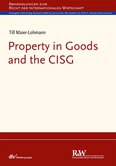34
The first task of this study is to establish a terminology with which the relevant legal questions can be analyzed. This section aims to allow for a clearer discussion in the following parts. It does not set out to answer the question of whether the implementation of a unitary, lump concept of property, which describes the most complete bundle of rights in a movable good, is a convincing solution to the problems posed.
35
Having chosen English as the language for this study, there is a natural link to the common law. This can, however, prove to be somewhat problematic when describing civil law concepts in property law in the English language.64 In particular, the English language has not one but three potential terms to describe somebody’s interest in goods: Some authors use “title”, while others prefer “ownership”, “property”, or combinations of these terms.65 Thus, from an outsider’s perspective, English law might appear to use these terms interchangeably.66 Yet, the English lawyer knows that under English law there are indeed discussions on the exact delineations. While it was long claimed that ownership was not a term of art, “ownership” is now used in the Consumer Rights Act 2015,67 and there is a notable dogmatic discussion on the use of “title” and “property” under the UK Sale of Goods Act 1979.68 Moreover, due to the dichotomy of common law in a narrow sense and equity law, rights, such as property or ownership, are split into a “bare legal title” and an “equitable title” that comes into existence with the creation of a “trust”.69 To further complicate matters, the English legal system lacks a coherent concept of property altogether. The law of property rather forms a mosaic of different statutes addressing property en passant and judge-made rules.70 Under Canadian law, “property” and “title” are both 16 used in sales law, but held to be “entirely different things”.71 Honnold assessed the “use of the complex, conclusionary legal idiom of ‘property’ [to have] led to confusion” in common law jurisdictions.72 Hence, in the English language, there is not one specific and appropriate term to describe what for example a German jurist would call property (Eigentum).73
36
Additionally, in uniform law, these terms are again used differently. The CISG uses the term “property” in Article 4, sentence 2(b) and Article 30. This could be understood to refer to a person’s rights over the goods.74 In contrast, “property” in Articles 7:110, 9:306 and 9:308 of the Principles of European Contract Law (PECL) is understood to refer to a thing, and not to a person’s rights over the thing. Article 7:110(1) of the PECL, for example, states: “A party who is left in possession of tangible property other than money because of the other party’s failure to accept or retake the property must take reasonable steps to protect and preserve the property.” When addressing a person’s rights over a thing in the realm of sales law and property law, other projects on the European level use “ownership”, as exemplified by the Draft Common Frame of Reference (DCFR).75 Notably, and to exhaust all possible terms used in international unification projects, there is a Convention du 15 avril 1958 sur la loi applicable au transfert de la propriété en cas de vente à caractère international d’objets mobiliers corporels by the Hague Conference on Private International Law. This Convention never entered into force and was drawn up in French. Yet, in the English translation of the convention, “propriété” is translated as “title”.
37
Against this background, it is not surprising that there is no prevailing terminology for the kind of research at hand. Since this study focuses on the interplay between national property law on the one hand and the CISG on the other, a terminological differentiation might have helped to highlight that the terms and concepts do not always fully overlap in their scope. Yet, this differentiation could not be used coherently for the full study: For example, the CISG refers to “property” in Articles 4 and 30. English law and the action for the purchase price under section 49(1) of the Sale of Goods 17 Act 1979, which will be discussed in detail below,76 also references “property” instead of “ownership” or “title”. To change the terminology when discussing this provision and English law in general would confuse rather than clarify. Therefore, distinguishing between “property” under the CISG and “ownership” or “title” under national law lacks persuasive clarity. Instead, this study will generally use “property” when addressing aspects that concern all notions of property (irrespective of whether under the CISG or national law). Property is thus understood in a broad manner to refer to a legal interest any party can have in the goods. In turn, the terminology employed in the work at hand does not match the European projects, such as the PECL and the DCFR, which refer to property as the thing itself. If a specific manifestation of property is referred to then this will either be obvious or the text will clarify what concept is meant, for example, property under Swiss law, or property under the CISG, or relative property. The person who has property in the goods is referred to as the owner.


